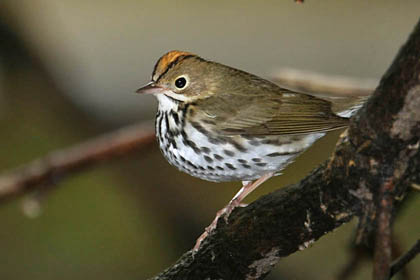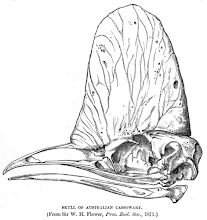AN UPDATE: The bird I found has been identified by my ever-so-gracious-and-intelligent-and-wonderful-etc. ornithology t.a. PAUL as an Ovenbird.
Sunday, October 9, 2011
Monday, May 23, 2011
mystery
ahh, summer 2011 hath commenced! my summer job doesn't start till the end of may, so i have had some time to get into some cool stuff, such as:
1. sleeping
2. lap swimming
3. building a spider terrarium
4. finding dead birds and harvesting their bones
very cool, very nice, but here's my issue: I CAN'T IDENTIFY IT AND IT'S DRIVING ME UP THE WALL!
presently, i only have pictures of the bird, as i decided to try to harvest its bones. [more about that later]. classic aubrie scenario: dissect first, ask questions later.
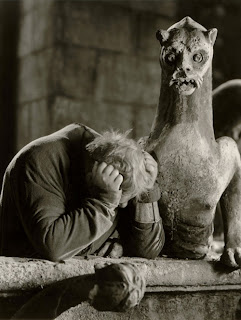
damn.
in any case, i'm going to try to walk you, my beloved reader, through trying to identify a very small, very wet, and very dead bird.
using only pictures.
maybe it will help me figure it out too?

whatever.
my first clue to my feathered friend's identity is the overall size and shape. this bird is [was] most definitely a passerine.


passerines are generally just the small cute birds you see flitting about your neighborhood. technically though, [and believe me, ornithologists LOVE "technically"] they are distinguished by their foot structure and singing abilities.
though i didn't hear this bird singing, [doi] the feet are a dead giveaway-- looks like these guys are the best perchers in the business! don't tell non-passerines though, i hear ostriches get jealous.
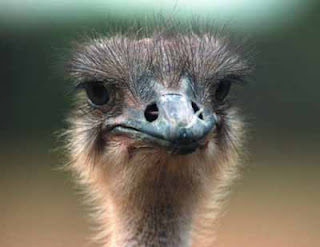
my next move was to look at the body's coloration. my little fren was olivey-yellow on the top bits, and whitish on the underbits. aside from that, there [annoyingly] wasn't very much that was distinctive about the coloration.
unfortunately, the head was in extremely poor condition. no eyeballs, and the hair-do was terribly askew. add that to the fact that it was sopping wet when i found it, and i had a pretty difficult time in identifying based on the head coloration.
-BUT-
i would like you to look at the top of the head. there is something that is bothering me about it...i will leave you guessing on what that particular thing is for right now.

can you feel the suspense?
next i wanted to look at the body length, weight, and wingspan. this particular bird was 5 inches long and 0.6 ounces. the wing chord (length of one wing) was 3 inches, so I am venturing to guess the wingspan was around 7-8 inches in total.
velly small, velly delicate.
other things i had to consider included:
1a. location- so, i'm probably not going to find a like, siberian plover or something running into my window during a storm. even if that species DID exist, it wouldn't occur in iowa.
1b. location- primary feathers give a lot about a bird away. if the primaries on a wing [see below] are really asymmetrical ["9" in diagram], you can be sure that the bird flies long distances.
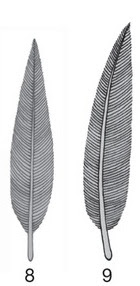
traveling long distances could be good for a lot of different things, but what i am alluding to is migration. check my guy's primaries:
asymmetrical.
WE HAVE A RUNNER
but really folks...this is a mildly complicating factor for number 1a. it's spring! everyone is going everywhere!
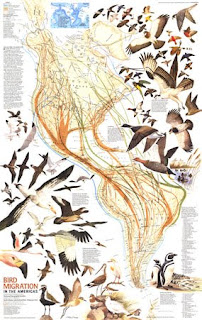
spring and fall migrations are birder's delights, but also make it so i can't automatically assume my specimen is an iowa resident. my species pool to consider gets a lot wider with this confounding factor. but in a good way!
it means i get to peruse one of my all-time favorite books...
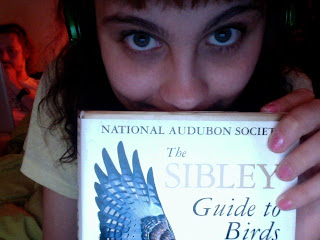
duh!
so after literally hours of looking through this book and using online sources, [thank you whatbird.com!] i've narrowed it down to a few options.
shall we see what is behind curtain number one?

ahh, the red-eyed vireo. very nice, but i have two issues with this choice:
1. vireos tend to have a slight hook in the maxilla [the upper part of the bill], whereas my specimen doesn't seem to. the shape just doesn't quite fit the --ahem--bill.
2. remember the head picture that was bothering me? it has an orangey color to it, but i can't tell if i'm imagining things or if that is actually a colored crown. if that were the case, none of the vireos would match with our specimen.
this leads me to curtain two, the ruby-crowned kinglet!
a worthy guess, with exceptions:
1. check out those white wing bars! my bird's wings are not that exciting.
2. kinglets are described in sibley's guide as being "dumpy" [?] i really think this species might be too small and squat to match my bird. still, it's got the coloration on the head and the olivey bit down.
let's check curtain number three, the sparrows:
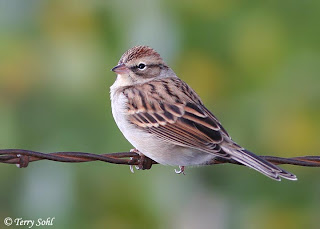
i'm thinking if this is a sparrow, it's probably something like a chipping sparrow. they're super common in iowa in the summer, and they've got a matching bill shape to my bird as well as a bright crown.
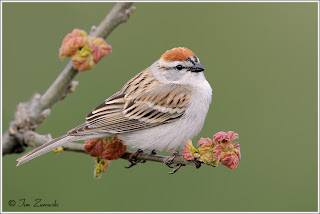
the problem is that they are probably too exciting looking to be my bird- so much pattern! and maybe not enough olive?
so, those are my three options. my best guess is the vireo, but really, who knows?
no really, did you figure it out? i'm going bonkers

i really love google image search. really.
if you have an idea, feel free to call me, e-mail me, or [fittingly] send some sort of homing pigeon.
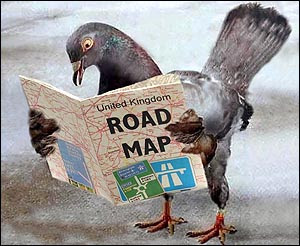
really.
or just leave a comment.
guess update: my friend jim had the idea of flycatchers. i could get on that boat. my only issue with flycatchers are their wingbars, which my bird seems to lack. also that questionable colored patch [?] on my guy's head. the least flycatcher is extremely likely though! jim should get a prize, like maybe a PhD in late June or something.

guess update number two: my mom thought it might be a miniature blue heron! maybe?...

uh, maybe not.
guess update number three: my community ecology professor suggested the thrushes, which i had at first written off for their larger size [robins are in the same family]. HOWEVER! the hermit thrush is just the right size and coloration!

also to consider: the swainson's thrush.
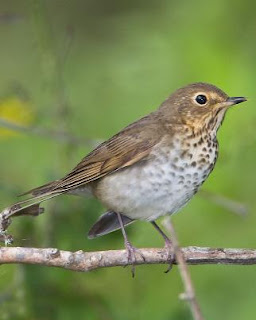
look ma, no wingbars! both species are in iowa during migration.
he also suggested the eastern phoebe:

which is very closely related to the least flycatcher. superb guesses! i would suggest a prize for my professor like i did for jim, but he already has a PhD.
to finish up this post, i'll give you a pictoral essay of how i am presently harvesting the bones from my mysterious feathered friend. the basic outline of the process is this: skin bird, place in warm water, let bacteria eat meaty bits, and remove bones, tissue free, after a coupla weeks!
clockwise from top: scale with bird, non-latex gloves, dissecting kit, makeshift dissecting plate, mesh bags for body parts, tape measure, notebook with pencil and ill-gotten picture of my ecology TA. am i creepy yet?
feather tract on wing
makeshift body [parts] bags
temperature monitor
inner maceration chamber

completed chamber with insulation components [okay, aluminum foil and duct tape. insulation components just sounds cool.]

twerp of the century.
easy! i'll post an update with pictures if it works out.
if you're interested, i adapted my method from this website. it's fun and inexpensive--one could say it's a pretty cheep venture!


sorry.
Thursday, February 17, 2011
the red queen
okay, when i say parasite, what comes to mind?
 ticks?
ticks? caterpillar hijackers?

scott disick of i-got-kourtney-kardashian-pregnant fame?
well i'll tell you what, when i hear the word parasite, i think of this:

wow, something bird related. weird!
look closely at the above picture, and you'll notice that the bigger bird is getting fed by the smaller bird. what's up with that?
well, this is no episode of "maury: my 10 month old baby is one hundred pounds" or whatever.

yeah that's really not the case here.
instead, something way cooler is happening: brood parasitism! in the above picture, what is portrayed is a young brown-headed cowbird being fed by a yellow warbler.
brown-headed cowbirds are birds in the blackbird family (Icteridae) that live in the great plains of north america, and though they lay their own eggs, they sure as hell don't want to take care of their babies.
i wouldn't either; baby cowbirds are seriously ugly and seriously altricial.

i guess taking care of babies takes a LOT of energy, because you have to provide everything for them, like:
-food
-shelter
-rides to their friends' houses
to save on energy, brood parasites [like cowbirds] have evolved a simple behavior that solves the problem of actually having to raise their own young:
[forced] adoption!

actually, forced adoption is a really nice term for what brood parasites do. Essentially, parasites, like the common cuckoo,
 greater honeyguide,
greater honeyguide,
and brown-headed cowbird,

lay their eggs in other species' nests.
this behavior usually translates into some pretty bad things for the host species, including, but not limited to:
1. their own babies dying
but aubrie, why do the host species babies die? can't the introduced young [cowbird, i.e.] and the host young live together happily?
well, simply put...NO

that would be a brown-headed cowbird hogging the bed AND the sheets.
generally, a brood parasites' young hatch earlier and grow at a faster rate than the host's young, and end up out-competing the host babies for food and room in the host nest.
great deal for the baby parasite, bad deal for the host baby.[bad deal like starvation and death]

way short straw deal
the thing about parasite eggs is that they are often hard for hosts to identify as parasite eggs. a lot of the time, birds figure: "well, it's in my nest, musta laid it!" and go on with their lives as if the egg was their own.
and when it hatches, i mean, you have to love your kids no matter what, right?
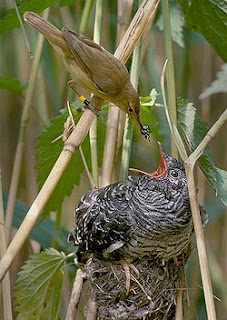
so, okay, birds aren't going to get rid of eggs they think are their own. and if the parasitic eggs "come to term" as it were, then they're going to get fed and thrive instead of the host species babies.
in fact, to really get the upper hand, the parasites might even get rid of the host eggs themselves:
what lies! what trickery! how treacherous! dang!
yet, there is hope for the hosts.

unfortunately, this hope comes via more baby and egg killin'
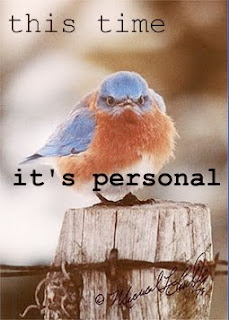
as parasites have developed behaviors to lay their eggs in other species' nests, some species have evolved counter-parasite protection plans. for example, the yellow warbler:

when the yellow warbler recognizes there is a foreign egg in its nest, it just builds a new nest to lay eggs in on TOP of the old one.
other birds, like catbirds, just get really angry and throw the eggs outta the nest. sometimes, in their fervor, they actually eject their own eggs out of the nest, too. whoops!
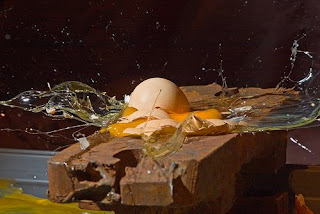
though it provides protection against the invaders, egg recognition and ejection is not the end of this evolutionary battle.
in fact, it is just the beginning.
to prevent host species from recognizing their eggs, cuckoos have developed the ability to lay eggs that look extremely similar to the host's eggs. check it:

the bottom eggs are the impostors. WOW!! that will make it hard to tell.
but aubrie, let's get real. birds can't do stuff like they're in some sort of technological war! they don't even have thumbs or laptop computers.
WRONG! [well, right about the thumbs and laptops bit, maybe] to illustrate and expand your brain, let's have a little evolutionary theory with a side of humiliTEA.

the phenomenon i've been describing to you has often been called an evolutionary arms race, because no matter what one species does to either:
take advantage of [parasite]
-or-
defend themselves [host]
the other will respond [evolutionarily] to keep the status quo.
it's called the red queen effect, after a quote by louis carroll in alice in wonderland.

relatively, though there is evolutionary change in the species, there is no net gain of one species over the other in the given interaction.
graphically, the interactions of host-parasite can be represented with a simple population frequency/generations graph:
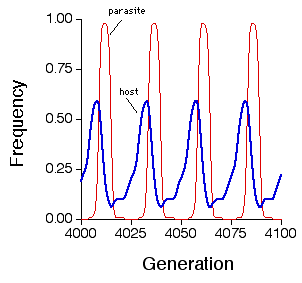
more individuals of the host in one generation causes greater success of the next generation of parasites. eloquent!
otherwise, the red queen effect can be represented in terms of fitness.

okay, don't get scared like i do when i see graphs [especially when they're small and black and white. b0ring, i like a little more PiZaZz.]
anyway, all the graph is demonstrating is that:
1. as the adaptiveness of the prey goes up
2. the exploitation of the prey by the predator goes down
basically, it's harder to be a predator when your prey knows all your tricks!
so, the predators eventually learn new tricks.

not quite
for our birds in evolutionary terms:
parasite learns to lay eggs in host nest to save energy--> host bird learns to recognize and eject parasite eggs to save babies --> parasite young ejects host eggs instinctually to out-compete host babies--> ?
looks like it's the host's move to defend...wonder where they'll move the red queen next?!
Subscribe to:
Posts (Atom)
